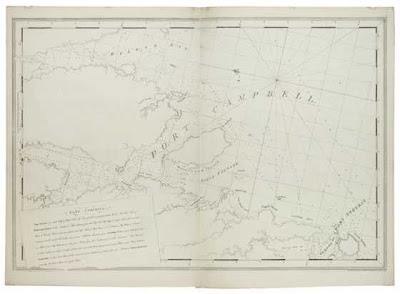 I have magnified this map and searched all over the shoreline for settlements. The only ones noted by the famously meticulous Des Barres (beside McNutt's place on the island) are two small clusters on the western shore of the harbour, across from what is now McNutt's Island. Des Barres called it Roseneath. There were no settlements at all where the Town of Shelburne now stands.
I have magnified this map and searched all over the shoreline for settlements. The only ones noted by the famously meticulous Des Barres (beside McNutt's place on the island) are two small clusters on the western shore of the harbour, across from what is now McNutt's Island. Des Barres called it Roseneath. There were no settlements at all where the Town of Shelburne now stands. It makes sense. The western channel, called False Passage, was and is relatively tranquil and shallow, and the clusters of settlements are protected. Each cluster is located near a small bay and a sandy beach. And they are close enough to the ocean that small boats could come in and go out without the effort it would take to sail or row all the way into the inner harbour.
It makes sense. The western channel, called False Passage, was and is relatively tranquil and shallow, and the clusters of settlements are protected. Each cluster is located near a small bay and a sandy beach. And they are close enough to the ocean that small boats could come in and go out without the effort it would take to sail or row all the way into the inner harbour. Today you can look across the western channel and see where those two settlements were so long ago, along the shore directly opposite here, at Carleton Village, and a bit south, directly across from the sheep pen, at Craine's Point and Roseway.
 Here is Des Barres' map of Barrington Bay from the same time, showing the lots and buildings in Barrington. By 1776 Barrington was a recognizable place. It was hard to get to Barrington from Port Roseway, though, even though it was so near. It was almost impossible to walk there, across spruce forest and deadfall and swamp, and difficult to maneuver boats through the shoals and breakers along the coast. It gives us the faintest idea of how isolated the people at Port Roseway must have been back then.
Here is Des Barres' map of Barrington Bay from the same time, showing the lots and buildings in Barrington. By 1776 Barrington was a recognizable place. It was hard to get to Barrington from Port Roseway, though, even though it was so near. It was almost impossible to walk there, across spruce forest and deadfall and swamp, and difficult to maneuver boats through the shoals and breakers along the coast. It gives us the faintest idea of how isolated the people at Port Roseway must have been back then.
 Here is Des Barres' map of Barrington Bay from the same time, showing the lots and buildings in Barrington. By 1776 Barrington was a recognizable place. It was hard to get to Barrington from Port Roseway, though, even though it was so near. It was almost impossible to walk there, across spruce forest and deadfall and swamp, and difficult to maneuver boats through the shoals and breakers along the coast. It gives us the faintest idea of how isolated the people at Port Roseway must have been back then.
Here is Des Barres' map of Barrington Bay from the same time, showing the lots and buildings in Barrington. By 1776 Barrington was a recognizable place. It was hard to get to Barrington from Port Roseway, though, even though it was so near. It was almost impossible to walk there, across spruce forest and deadfall and swamp, and difficult to maneuver boats through the shoals and breakers along the coast. It gives us the faintest idea of how isolated the people at Port Roseway must have been back then. Pages from The Atlantic Neptune are courtesy of the National Maritime Museum, London England.




.gif)
No comments:
Post a Comment